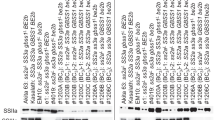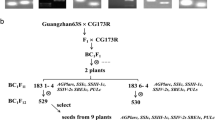Abstract
The Wx gene encoding granule-bound starch synthase is responsible for the biosynthesis of amylose, which plays an important role in determining rice eating and cooking quality. However, the functional evaluation of different Wx alleles remains unclear. In the present study, a set of near-isogenic lines (NILs) carrying four different Wx alleles—Wx a , Wx b , Wx in, and wx—was developed in the genetic background of indica rice cv. Yangfunuo 4 (YFN 4), and designated NIL-Wx a, NIL-Wx b, NIL-Wx in, and NIL-wx, respectively. These NILs show great variations in amylose content (AC), gel consistency (GC), starch viscosity, and thermodynamic property. AC showed the following trend among different NILs: NIL-Wx a > NIL-Wx in > NIL-Wx b > NIL-wx, but the opposite trend for GC. NIL-Wx a and NIL-Wx in had lower starch thermodynamic properties, such as onset temperature, peak temperature, and conclusion temperature, when compared with both NIL-Wx b and NIL-wx. The transcript and protein of Wx gene were not detectable in the NIL-wx line. The accumulation levels of Wx transcript and Wx protein were higher in NIL-Wx a than those in NIL-Wx b and NIL-Wx in. Therefore, Wx gene was closely related to starch quality parameters, such as AC, GC, starch paste viscosity, and starch thermodynamic property. Our results provide a solid foundation for rice grain quality improvement through marker-assistant selection.





Similar content being viewed by others
References
Aluko G, Martinez C, Tohme J, Castano C, Bergman C, Oard JH (2004) QTL mapping of grain quality traits from the interspecific cross Oryza sativa×O. glaberrima. Theor Appl Genet 109:630–639
American Association of Cereal Chemists (2000) Approved methods for the AACC, 10th edn. Method 61–01 (amylograph method for milled rice) and Method 61–02 (determination of the pasting properties of rice with rapid visco analyzer). The Association, St. Paul, MN
Ayres NM, McClung AM, Larkin PD, Bligh HFJ, Jones CA, Park WD (1997) Microsatellites and a single-nucleotide polymorphism differentiate apparent amylose classes in an extended pedigree of US rice germplasm. Theor Appl Genet 94:773–781
Bao JS, Zheng XW, Xia YW, He P, Shu QY, Lu X, Chen Y, Zhu LH (2000) QTL mapping for the paste viscosity characteristics in rice (Oryza sativa L.). Theor Appl Genet 100:280–284
Bao JS, Harold C, He P, Zhu LH (2003) Analysis of quantitative trait loci for starch properties of rice based on an RIL population. Acta Bot Sin 45:986–994
Bason ML, Blakenet AB, Booth RI (1994) Assessing rice quality using RVA results of an international collaborative trial. RVA world 6:2–54
Cagampang GB, Perez CM, Juliano BO (1973) A gel consistency test for eating quality in rice. J Sci Food Agric 24:1589–1594
Cai XL, Wang ZY, Xing YY, Zhang JL, Hong MM (1998) Aberrant splicing of intron 1 leads to the heterogeneous 5′UTR and decreased expression of waxy gene in rice cultivars of intermediate amylose content. Plant J 14:459–465
Cai XL, Liu QQ, Tan SZ, Gu MH, Wang ZY (2002) Development of a molecular marker for screening the rice cultivars with intermediate amylose content in Oryza sativa subsp. Indica J Plant Physiol Mol Biol 28:137–144 (in Chinese with English abstract)
Fan CC, Yu XQ, Xing YZ, Xu CG, Luo LJ, Zhang QF (2005) The main effects, epistatic effects and environmental interactions of QTLs on the cooking and eating quality of rice in a doubled-haploid line population. Theor Appl Genet 110:1445–1452
Han YP, Xu ML, Liu XY, Yan CJ, Korban SS, Chen XL, Gu MH (2004) Genes coding for starch branching enzymes are major contributors to starch viscosity characteristics in waxy rice (Oryza sativa L.). Plant Sci 166:357–364
He P, Li SG, Qian Q, Ma YQ, Li JZ, Wang WM, Chen Y, Zhu LH (1999) Genetic analysis of grain quality. Theor Appl Genet 98:502–508
He Y, Han YP, Jiang L, Xu CW, Lu JF, Xu ML (2006) Functional analysis of starch-synthesis genes in determining rice eating and cooking qualities. Mol Breed 18:277–290
Juliano BO (1971) A simplified assay for milled rice amylose. Cereal Sci Today 16:334–340
Juliano BO (1985) Criteria and test for rice grain quality. In: Juliano BO (ed) Rice chemistry and technology. American Association of Cereal Chemists, St. Paul, pp 443–513
Li QF, Sun SSM, Yuan DY, Yu HX, Gu MH, Liu QQ (2010) Validation of candidate reference genes for the accurate normalization of real-time quantitative RT-PCR data in rice during seed development. Plant Mol Biol Rep 28:49–57
Liu QQ, Yu HX, Chen XH, Cai XL, Tang SZ, Wang ZY, Gu MH (2005) Field performance of transgenic indica hybrid rice with improved cooking and eating quality by down-regulation of Wx gene expression. Mol Breeding 16:199–208
Liu QQ, Li QF, Cai XL, Wang HM, Tang SZ, Yu HX, Wang ZY, Gu MH (2006) Molecular marker-assisted selection for improved cooking and eating quality of two elite parents of hybrid rice. Crop Sci 46:2354–2360
Mikami I, Uwatoko N, Ikeda Y, Yamaguchi J, Hirano HY, Suzuki Y, Sano Y (2008) Allelic diversification at the wx locus in landraces of Asian rice. Theor Appl Genet 116:979–989
Morell MK, Kosar-Hashemi B, Cmiel M, Samuel MS, Chandler P, Rahman S, Buleon A, Batey IL, Li Z (2003) Barley sex6 mutants lack starch synthase IIa activity and contain a starch with novel properties. Plant J 34(2):173–185
Nakamura Y (2002) Towards a better understanding of the metabolic system for amylopection biosynthesis in plants: rice endosperm as a model tissue. Plant Cell Physiol 43(7):718–725
Ramamoorthy R, Jiang SY, Kumar N, Venkatesh PN, Ramachandran S (2008) A comprehensive transcriptional profiling of the WRKY gene family in rice under various abiotic and phytohormone treatments. Plant Cell Physiol 49(6):865–879
Sano Y (1984) Differential regulation of waxy gene expression in rice endosperm. Theor Appl Genet 64:467–473
Septiningsih EM, Trijatmiko KR, Moeljopawiro S, McCouch SR (2003) Identification of quantitative trait loci for grain quality in an advanced backcross population derived from the Oryza sativa variety IR64 and the wild relative O. rufipogon. Theor Appl Genet 107:1433–1441
Tan YF, Li JX, Yu SB, Xing YZ, Xu CG, Zhang QF (1999) The three important traits for cooking and eating quality of rice grains are controlled by a single locus in an elite rice hybrid, Shanyou 63. Theor Appl Genet 99:642–648
Tian ZX, Qian Q, Liu QQ, Yan MX, Liu XF, Yan CJ, Liu GF, Gao ZY, Tang SZ, Zeng DL, Wang YH, Yu JM, Gu MH, Li JY (2009) Allelic diversity in rice starch biosynthesis pathway leads to a diverse array of rice eating and cooking qualities. Proc Natl Acad Sci USA 106:21760–21765
Tian ZX, Yan CJ, Qian Q, Yan S, Xie HL, Wang F, Xu JF, Liu GF, Wang YH, Liu QQ, Tang SZ, Li JY, Gu MH (2010) Development of gene-tagged molecular markers for starch synthesis related genes in rice. Chin Sci Bull. doi:10.1007/s11434-010-0000-2
Umemoto T, Aoki N (2005) Single-nucleotide polymorphisms in rice starch synthase IIa that alter starch gelatinization and starch association of the enzyme. Funct Plant Biol 32:763–768
Umemoto T, Yano M, Satoh H, Shomura A, Nakamura Y (2002) Mapping of a gene responsible for the difference in amylopectin structure between japonica-type and indica-type rice varieties. Theor Appl Genet 104:1–8
Wanchana S, Toojinda T, Tragoonrung S, Vanavichit A (2003) Duplicated coding sequence in the waxy allele of tropical glutinous rice (Oryza sativa L.). Plant Sci 165:1193–1199
Wang ZY, Zheng FQ, Shen GZ, Gao JP, Snustad DP, Li MG, Zhang JL, Hong MM (1995) The amylose content in rice endosperm is related to the post-transcriptional regulation of the waxy gene. Plant J 7:613–622
Wang LQ, Liu WJ, Xu Y, He YQ, Luo LJ, Xing YZ, Xu CG, Zhang QF (2007) Genetic basis of 17 traits and viscosity parameters characterizing the eating and cooking quality of rice grain. Theor Appl Genet 115:463–476
Waters DL, Henry RJ, Reinke RF, Fitzgerald MA (2006) Gelatinization temperature of rice explained by polymorphisms in starch synthase. Plant Biotechnol J 4(1):115–122
Yan CJ, Fang YW, Li M, Peng JC, Liu QQ, Tang SZ, Gu MH (2010) Genetic effect of PUL allelic variation on rice cooking and eating qualities. Acta Agron Sin 36(5):728–735
Yu HX, Liu QQ, Li X, Lu MF, Yang XJ, Gong ZY, Cai XL, Zhang YS, Zhang CQ, Wang ZY, Gu MH (2009) Quality characteristics and field performance of selectable marker-free transgenic rice with antisense Wx gene and improved quality derived from the elite parents of hybrid indica rice. J Cereal Sci 50:370–375
Yu G, Olsen KM, Schaal BA (2011) Association between nonsynonymous mutations of starch synthase IIa and starch quality in rice (Oryza sativa). New Phytol 189(2):593–601
Zhou PH, Tan YF, He YQ, Xu CG, Zhang QF (2003) Simultaneous improvement for four quality traits of Zhenshan 97, an elite parent of hybrid rice, by molecular marker-assisted selection. Theor Appl Genet 106:326–331
Zhou XJ, Li J, Cheng W, Liu H, Li MM, Zhang Y, Li WB, Han SC, Wang YD (2010) Gene structure analysis of rice ADP-ribosylation factors (OsARFs) and their mRNA expression in developing rice plants. Plant Mol Biol Rep 28:692–703
Acknowledgements
This study was financially supported by the Ministry of Science and Technology (Grant No. 2005CB120804 and 2006AA10Z118), the National Natural Science Foundation (Grant No. 30771323 and 30871501), Fok Ying Tung Education Foundation (101030) and the Jiangsu Province Government (Grant No. 08KJA210002) of China.
Author information
Authors and Affiliations
Corresponding author
Additional information
Z. Zhang and M. Li contributed equally to this work.
Electronic Supplementary Material
Below is the link to the electronic supplementary material.
ESM 1
(DOC 52 kb)
Rights and permissions
About this article
Cite this article
Zhang, Z., Li, M., Fang, Y. et al. Diversification of the Waxy Gene is Closely Related to Variations in Rice Eating and Cooking Quality. Plant Mol Biol Rep 30, 462–469 (2012). https://doi.org/10.1007/s11105-011-0362-x
Published:
Issue Date:
DOI: https://doi.org/10.1007/s11105-011-0362-x




